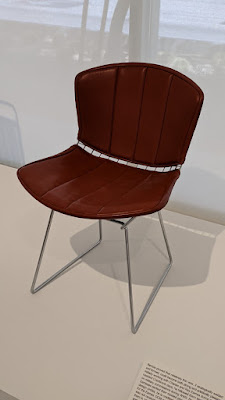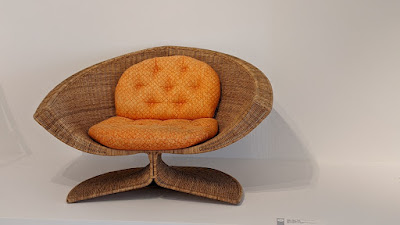The Modern Chair & Marilyn: Our Palm Springs Morning
We have been trying to get to an exhibit at the Palm Springs Art Museum Architecture & Design Center for years. We knew the timing was right for this one.
"The Modern Chair follows the development of the modern chair, highlighting its evolution and progression from two outstanding early examples-a bent wood Thonet classic from the dawn of the 20th century and the first cantilevered chair by Mart Stam of the Bauhaus school-through the fertile and innovative mid-century years and concluding with contemporary specimens. New industrial materials, technological and stylistic advances pushed chair design forward during the last century faster than at any time before.""Chairs illustrate our inventiveness and changing sense of fashion. They illustrate architectural trends as well as socioeconomic and societal concerns, symbolic content, and aspirational longings. This eclectic overview does not attempt to be comprehensive, authoritative, or rigorously academic but strives to illustrate how the challenge of chair design seems endlessly to ignite creativity and experimentation. More than any other piece of furniture, chairs reflect and express the way we live and have lived." -Brad Dunning
This is Gebrüder Thonet's famous “B-9” bentwood armchair (circa 1905), which is widely considered the first modern chair. Le Corbusier frequently used it in his early architecture as there was no other modern furniture readily available at the time.
If you were to guess when this chair was designed would it have been 1918? Gerrit Rietveld's Red Blue Chair surprised.
Marcel Breuer's the Wassily Chair (1927) is one of the most radical pieces of early modernist furniture. It deconstructs a traditional overstuffed club chair to its basic outline, removing all the stuffed upholstery. The body of the sitter almost appears to float in space, cradled in the slings and not touching the steel framework. The chair was nicknamed the Wassily after artist Wassily Kandinsky, Breuer's good friend and fellow teacher at the Bauhaus. A groundbreaking example of intellectual modernism which forever changed the course of furniture design. I think this was the one that impressed Steve the most!
Brothers Charles and Ray Eames, along with Eero Saarinen, created the Organic Chair, ca. 1940. This represents a seminal lodestone of midcentury chair design. A true breakthrough, the chair was developed in collaboration for the Organic Design in Home Furnishings competition organized by the Museum of Modern Art in New York. Its biomorphic shape was created by having the interior of the chair formed out of molded, lightweight plywood. Eventually each designer would incorporate various aspects of this design into their own chairs-Eames with the Plastic Armchair series and Saarinen with his Tulip series. Due to technical production difficulties at the time, very few examples of this Organic Chair were made.
One of the most monumental chairs ever produced, the Barcelona Chair by Ludwig Mies van der Rohe, epitomizes elegance, luxury, and modernity. Though only two were made originally for the German Pavilion at the Barcelona Exposition of 1929, the chair has since become one of the ultimate status symbols. It has been called "the Rolex and Rolls Royce of 20th century chairs." Perhaps not the most comfortable of chairs, its aesthetic design triumphs the ergonomic in this supreme example.
Atop the Mt. Olympus of Danish furniture design sits "The Master of the Chair," Hans Wegner. His numerous designs are universally recognized as masterpieces of craftsmanship and comfort. Wegner's labor intensive and smartly engineered chairs take organic modernism to its highest level. For his Round Chair (right), eleven different pieces of shaped wood are cleverly combined to form the appearance of a continuous semi-circle of wood. In 1950, Interiors magazine declared it "the most beautiful chair in the world." Richard Nixon and John Kennedy sat in these chairs for their famous 1960 television debates.
Gio Ponti's 1951 Superleggera ("beyond light" it weighs a little more than 3 pounds) is a marvel of style and engineering. The chair is strong and sturdy (it can hold 350 lbs) despite its delicate appearance. One of the most famous chair advertisements in design history features a sharply dressed boy easily lifting this chair with one finger.Harry Bertoia's Welded Wire Side Chair (1952) proved that relatively thin wire, if strategically welded and formed, could become both strong and artistically pleasing. Initially working with Charles and Ray Eames during their nascent Cranbrook days, he followed them west to work on military commissions during WWII. Bertoia helped the Eameses perfect their molded plywood inventions, and, in design circles,he is credited with designing the metal base for the Eames' DCM and LCM chairs. When Bertoia felt he was not receiving deserved credit from the Eameses, he left them in 1946. The similarities between Bertoia's Wire Chair and the Eames' Wire Chair led Herman Miller, manufacturer of the Eames' line, to sue Knoll, the manufacturer of Bertoia's chairs. The more artistic version of these chairs remains a volatile subjective debate. Who knew chair designing could have so much drama and intrigue?
This has to be one of the most unique in the exhibition. The description reads, "Price Tower in Bartlesville, Oklahoma was Frank Lloyd Wright's only realized skyscraper. As with most of his best work, he designed every detail of the project, including the furniture. The Casual Armchair was designed for various spaces in the building, including CEO Harold Charles Price's executive office. The cast aluminum chair complements the aluminum casing of the building's exterior windows. Idiosyncratic and inspired by nature-and in this case with a strong Japanese influence-Wright's singular and astounding vision remains unparalleled."
Eero Saarinen's 1955 Tulip Armchair is a history-making breakthrough in chair design. Bemoaning the "slum of legs," he wanted to "make the chair all one thing again." The most elegant, beautiful, and important one-legged chair ever designed, it allowed unprecedented flexibility and comfort: feet and legs were freed from collision as with traditional chair legs. The chair came first, then the equally famous table. They remain notable examples of perfect design.
Okay, this might be the strangest of all the chairs. In 1966, Roger Tallon was commissioned by the owner of a French disco, The Garage, to devise a flexible design for the former industrial space in Paris. Tallon created a module system consisting of a 40 x 40 centimeter grid. He covered the entire floor with metal slabs or tiles in that size. As needed or desired, a person could take one tile out and set in its place one of these chairs with the same size base, or even barstools and coat racks which would fit in the same size opening. For cushioning, and perhaps because of budgetary restraints, Tallon used humble, non-archival latex packing foam. Industrial chic at its chicest.
The biggest surprise was Frank Gehry's Beaver Chair and Ottoman, 1987. This chair offers perhaps the most extreme example of the disparity between the cost of construction material (prosaic and utilitarian corrugated cardboard), and the current auction price of this highly collectible design (upwards of $12,000 and climbing). Irreverent, ingenious, and reflective of Frank Gehry's outlaw rebellious L.A. style, his cardboard series, Easy Edges, was not only low cost at the time and structurally sound, but above all artistic and revolutionary.
Another chair using unique materials is Tokujin Yoshioka's 2001 Honey-Pop Chair. An ingenious hybrid of old and new technology rooted in historical Asian design, the Honey-Pop Chair is made of thin sheets of paper like the kind used in Chinese lanterns. The honeycomb design gives a strong structure. The chair is packed and shipped folded flat. Once opened, accordion style, the first sitter creates an impression that forms a personalized seat. Wow, right?
Cini Boeri made this piece entirely from a single monolithic piece of 1/2" glass. Each Ghost Chair is unique, reflecting the individual glass artist's control of the manufacturing process. Having worked for both Gio Ponti and Marco Zanuso before setting off on her own, Boeri draws on the Italian legacy of glass manufacturing and design, as practiced by the artisans of Murano. The designer redefines in a single gesture what glass was capable of.
Five years later they created this very groovy Rocking Shell Chair. One material that embodies California midcentury design is fiberglass- surfboards and Eames chairs being two of the best examples of its use. This chair's ubiquitous visual bombardment, seen in thousands of airports, schools, restaurants, and hundreds of other institutions,, might have numbed us to its greatness. Nevertheless, the Eames fiberglass chair encapsulates a period in a succinct, immediate, nostalgic, and distinctive way, becoming an icon of its era.
This exceptional exhibit opened our eyes to the artistry and importance of the chair in our lives. Architect Le Corbusier said of the chair, "Chairs are architecture, sofas are bourgeois." Cool stuff.
Our last stop was to visit the infamous Big Marilyn. Forever Marilyn is a giant statue of Marilyn Monroe designed by Seward Johnson (of the Johnson & Johnson family whose story needs to be read). The statue has been displayed in a variety of locations in the United States, as well as in Australia. This is its second visit to Palm Springs.
The 26-foot-tall, 34,000-pound sculpture, manufactured of painted stainless steel and aluminum, is a super-sized tribute to Marilyn Monroe's iconic scene from Billy Wilder's 1955 infidelity comedy, The Seven-Year Itch, with the figure capturing the instant a blast of air from a NYC subway grate raises her white dress. She is definitely worth the photo opportunities.
Our last stop was to visit the infamous Big Marilyn. Forever Marilyn is a giant statue of Marilyn Monroe designed by Seward Johnson (of the Johnson & Johnson family whose story needs to be read). The statue has been displayed in a variety of locations in the United States, as well as in Australia. This is its second visit to Palm Springs.
The 26-foot-tall, 34,000-pound sculpture, manufactured of painted stainless steel and aluminum, is a super-sized tribute to Marilyn Monroe's iconic scene from Billy Wilder's 1955 infidelity comedy, The Seven-Year Itch, with the figure capturing the instant a blast of air from a NYC subway grate raises her white dress. She is definitely worth the photo opportunities.
Palms Springs continues to be one of those places that draws us. It is diverse, unique and only 68 miles from our Temecula home.





























1 comments:
I have not seen that Marilyn statue before. It’s pretty amazing.
I have a ticket for the architecture museum. We will have to check it out. Palm Springs is the best!
Post a Comment